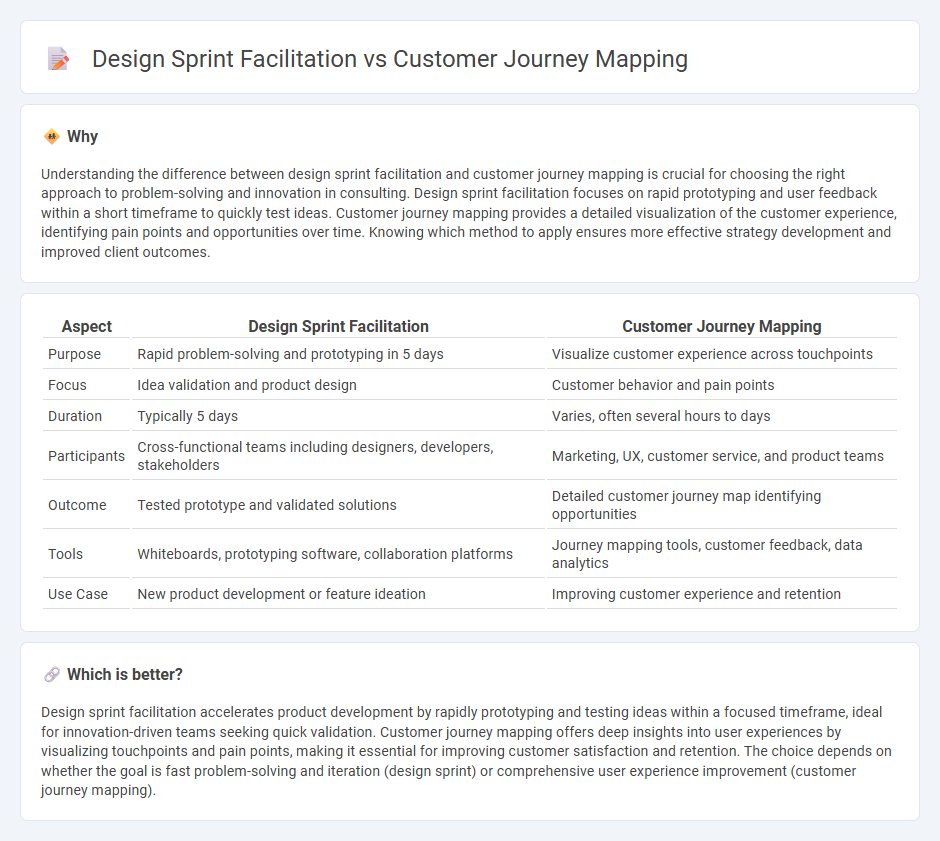
Design sprint facilitation accelerates innovation by guiding teams through rapid prototyping and user testing within a structured timeframe, focusing on problem-solving and decision-making. Customer journey mapping provides a comprehensive visualization of user interactions across all touchpoints, identifying pain points and opportunities for enhancing the overall customer experience. Explore how leveraging both techniques can transform your consulting outcomes and drive strategic growth.
Why it is important
Understanding the difference between design sprint facilitation and customer journey mapping is crucial for choosing the right approach to problem-solving and innovation in consulting. Design sprint facilitation focuses on rapid prototyping and user feedback within a short timeframe to quickly test ideas. Customer journey mapping provides a detailed visualization of the customer experience, identifying pain points and opportunities over time. Knowing which method to apply ensures more effective strategy development and improved client outcomes.
Comparison Table
| Aspect | Design Sprint Facilitation | Customer Journey Mapping |
|---|---|---|
| Purpose | Rapid problem-solving and prototyping in 5 days | Visualize customer experience across touchpoints |
| Focus | Idea validation and product design | Customer behavior and pain points |
| Duration | Typically 5 days | Varies, often several hours to days |
| Participants | Cross-functional teams including designers, developers, stakeholders | Marketing, UX, customer service, and product teams |
| Outcome | Tested prototype and validated solutions | Detailed customer journey map identifying opportunities |
| Tools | Whiteboards, prototyping software, collaboration platforms | Journey mapping tools, customer feedback, data analytics |
| Use Case | New product development or feature ideation | Improving customer experience and retention |
Which is better?
Design sprint facilitation accelerates product development by rapidly prototyping and testing ideas within a focused timeframe, ideal for innovation-driven teams seeking quick validation. Customer journey mapping offers deep insights into user experiences by visualizing touchpoints and pain points, making it essential for improving customer satisfaction and retention. The choice depends on whether the goal is fast problem-solving and iteration (design sprint) or comprehensive user experience improvement (customer journey mapping).
Connection
Design sprint facilitation accelerates innovation by rapidly prototyping solutions, while customer journey mapping provides detailed insights into user experiences and pain points. Integrating these methods enables consultants to focus sprint activities on critical customer touchpoints, ensuring solutions are aligned with actual user needs and behaviors. This synergy enhances problem-solving effectiveness and maximizes value delivery throughout project cycles.
Key Terms
Touchpoints
Customer journey mapping identifies critical touchpoints to understand user experiences and pain points across various stages, enhancing process optimization and customer satisfaction. Design sprint facilitation leverages these touchpoints to rapidly prototype and test solutions, ensuring targeted outcomes aligned with user needs. Explore how mastering touchpoints in both methods can drive innovation and improve strategic decisions.
Empathy mapping
Customer journey mapping provides a comprehensive visualization of customer interactions, uncovering emotions, pain points, and moments of delight throughout the buying process. Design sprint facilitation leverages empathy mapping to quickly align teams on user needs, fostering rapid ideation and problem-solving during collaborative workshops. Explore how integrating these approaches can enhance user-centric innovation and streamline product development.
Rapid prototyping
Customer journey mapping identifies user pain points and behaviors to inform solution development, emphasizing detailed user experience insights. Design sprint facilitation accelerates idea validation through rapid prototyping, enabling teams to test and iterate solutions quickly within a condensed timeframe. Discover how integrating both approaches maximizes innovation speed and user-centric outcomes.
Source and External Links
The customer journey map and why it's important - A customer journey map visually represents the touchpoints and experiences customers have with a company, helping businesses predict behavior, anticipate needs, and improve interactions by mapping stages such as personas, touchpoints, and pain points.
What is a Customer Journey Map? - IBM - A customer journey map visualizes every customer experience with a brand by creating data-driven personas, identifying key stages, touchpoints, emotions, pain points, and validating the journey with real customers.
Customer Journey Maps: How to Create Really Good Ones ... - Customer journey mapping compiles and visually represents the customer's experience with a company across multiple channels and touchpoints, highlighting that customer journeys are often nonlinear and cyclical.
 dowidth.com
dowidth.com